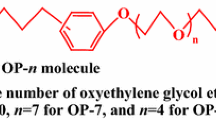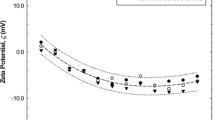Abstract
The surface properties of quasi-ternary systems comprising two surfactants in water were studied in the light of previously published hypotheses of specific two-dimensional arrangements of associated surfactant molecules and compatibility of their hydrophobic chains. In contrast to the studies of model ternary systems of pure components reported previously in the literature, the title quasi-ternary systems were prepared as water solutions of two polydisperse mixtures of surfactants: an anionic one (quasi-component 1) and nonionic one (quasi-component 2). The complex quasi-components used were polydisperse in terms of both ethylene oxide substituent numbers and the carbon chain length, obtained as received under industrial conditions from commercial raw materials. The novel surfactants which are the subject of the present study were synthesized by elongation of the hydrophobic chain of 2-ethylhexan-1-ol molecules by catalytic polyaddition of methyloxirane (propylene oxide), followed by introduction into the resulting transformed structure of a hydrophilic group (in the form of a polyether chain and/or a sulfosuccinate group). All synthesized surfactants were therefore polydispersed mixtures of methyloxirane and oxirane (ethylene oxide) homologues. It was shown that, in the case of the quasi-ternary aqueous systems studied, the extrema of the investigated functions describing the surface properties occur in the neighborhood of some specific stoichiometric ratios of the surfactant concentrations, namely 1:3/3:1. On the other hand, synergistic effects associated with the compatibility of the hydrophobic chains studied were not confirmed.



















Similar content being viewed by others
References
HERA (2009) Human and Environmental Risk Assessment: Ingredients of European household cleaning products–alcohol ethoxylates, version 2.0. HERA, Brussels, p 19
Hreczuch W, Sznajdrowska A, Materna K, Sokołowski A, Reksa D, Wanxu W, Qiuxiao L, Yongqiang S (2012) 2-Ethylhexyl alcohol derived surfactants. 2012 International exhibition and conference on surfactant and detergent, 14–16 April, Shanghai, China
Bergstrom K (2003) An alkoxylate mixture and its use as a cleaning agent for hard surfaces. Patent EP 1 519 907 B1
Hreczuch W, Domarecki W, Domarecka D, Materna K, Pernak J, Sokołowski A, Marciński M, Mosio-Mosiewski M, Sznajdrowska A, Janik J, Szymiec D (2011) Patent PL 215601
The DOW Chemical Company (2009) ECOSURF™ EH specialty surfactants, form no. 119-02244-0309
Shah DO (1971) Significance of the 1:3 molecular ratio in mixed surfactant systems. J Colloid Interface Sci 37:744–752. doi:10.1016/0021-9797(71)90353-5
Shah DO, Schulman JH (1967) Influence of calcium, cholesterol, and unsaturation on lecithin monolayers. J Lipid Res 8:215–226
Booij HL (1969) Extraction of oil from emulsions. J Colloid Interface Sci 29:365–380. doi:10.1016/0021-9797(69)90205-7
Patist A, Chabra V, Pagidipati R, Shah R, Shah DO (1997) Effect of chain length compatibility on micellar stability in sodium dodecyl sulfate/alkyltrimethylammonium bromide solutions. Langmuir 13:432–434. doi:10.1021/la960838t
Shiao SY, Chhabra V, Patist A, Free ML, Huibers DPT, Gregory A, Patel S, Shah DO (1998) Chain length compatibility effects in mixed surfactant systems for technological applications. Adv Colloid Interface Sci 74:1–29. doi:10.1016/S0001-8686(97)00005-5
Shah DO (ed) (1998) Micelles, microemulsions and monolayers. Dekker, New York, pp 1–50
Janik J, Chruściel A (2015) Activity and selectivity of alkaline and double metal cyanide catalysts in ethoxylation of fatty alcohols. Przem Chem 94(8):1404–1410. doi:10.15199/62.2015.8.32
Chruściel A, Hreczuch W, Janik J, Czaja K, Dziubek K, Flisak Z, Swinarew A (2014) Characterization of a double metal cyanide (DMC)-type catalyst in the polyoxypropylation process: effects of catalyst concentration. Ind Eng Chem Res 53:6636–6646. doi:10.1021/ie500031j
Hreczuch W, Krasnodębski Z, Szymanowski J (1993) Effect of narrowing oxirane adduct distribution on some properties of ethoxylated alcohol-based sulfosuccinic acid halfesters. J Am Oil Chem Soc 70:707–710
Chengbin H, Qiuxiao L, Ming L, Jinpin N, Yongbo S (2014) Synthesis and properties of Guerbet hexadecyl sulfate. Tenside Surfact Det 51(6):506–510. doi:10.3139/113.110335
Acknowledgments
This work was supported by the National Centre for Research and Development (NCBR): Applied Research Program (PBS 1 2012-2015), Project No. PBS1/A5/28/2012 (EH-SURF).
Author information
Authors and Affiliations
Corresponding author
About this article
Cite this article
Chruściel, A., Hreczuch, W., Dąbrowska, K. et al. Interfacial Activity of 2-Ethylhexan-1-ol-Based Surfactants in Quasi-ternary Systems. J Surfact Deterg 20, 83–101 (2017). https://doi.org/10.1007/s11743-016-1888-6
Received:
Accepted:
Published:
Issue Date:
DOI: https://doi.org/10.1007/s11743-016-1888-6




